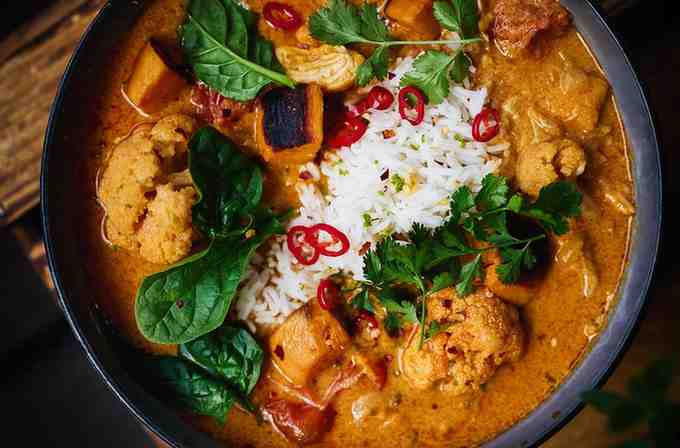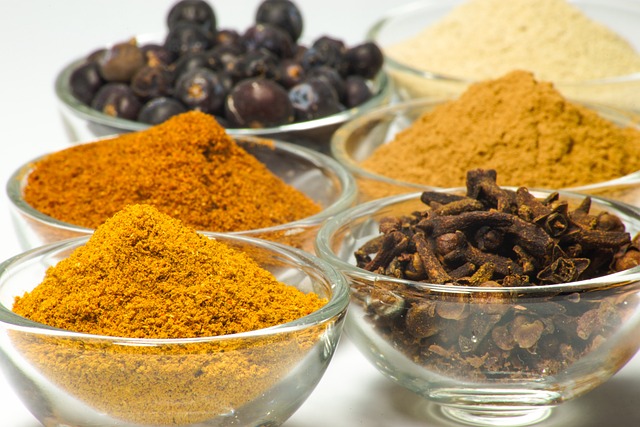Curry sauce is a cornerstone of many cuisines, offering a rich, aromatic blend of spices and ingredients. From Indian curries to Thai dishes, this versatile sauce adds depth, warmth, and complexity to meals. Whether you’re a seasoned cook or a beginner, mastering the art of curry sauce can elevate your culinary skills and transform your dishes into something extraordinary.
Understanding the Core Components of Curry Sauce
Aromatics: The Foundation of Flavor
Aromatics create the first layer of taste and aroma, forming the essential foundation of curry sauce. These ingredients, when sautéed or fried, release their natural oils and deepen the sauce’s flavor.
- Onions: These add natural sweetness and form a thick base when caramelized. Red onions, yellow onions, or shallots are commonly used based on the cuisine.
- Garlic: Garlic contributes a savory punch that complements the other spices. Freshly minced garlic works best for vibrant flavor.
- Ginger: This ingredient provides a warm, peppery undertone. In Indian curries, grated fresh ginger is preferred, while Thai curries may use galangal as a substitute.
Essential Spices
Spices define the curry’s flavor profile, making it bold, complex, and satisfying. Each spice brings a unique note to the dish, and the way they are combined varies across cultures.
- Turmeric: Its earthy, slightly bitter flavor and bright yellow color are indispensable in most curry sauces.
- Cumin: This spice is earthy and smoky, often roasted before adding to enhance its depth.
- Coriander: The mild citrus flavor of coriander seeds or powder balances the curry’s richness.
- Curry Powder: A pre-mixed blend of spices that can include turmeric, cumin, coriander, fenugreek, and chili powder. Its use varies across cuisines.
- Garam Masala: Often added at the end, this spice blend provides warmth and aroma in Indian curries.

Liquid Base
The liquid component binds the curry sauce together and determines its consistency and richness. Choosing the right liquid base influences the dish’s final flavor and texture.
- Coconut Milk: Common in Thai and Caribbean curries, it adds creaminess and a subtle sweetness that balances spicy flavors.
- Tomato Puree or Paste: This provides a tangy, acidic base for Indian-style curries. It also thickens the sauce and enhances the spices.
- Broth: Vegetable, chicken, or beef broth adds depth without overpowering the spices. Broth is often used in lighter curries or as a supplement to tomato or coconut bases.
Flavor Enhancers
To elevate the curry sauce further, chefs use additional flavor enhancers that round out the dish.
- Chilies: Fresh or dried chilies add heat, while chili powder contributes both color and spice. Adjust according to your heat tolerance.
- Acidity: Lime juice, tamarind, or vinegar brighten the sauce and balance richness.
- Herbs: Fresh cilantro, curry leaves, or Thai basil are often added at the end for a burst of freshness.
Step-by-Step Guide to Making a Basic Curry Sauce
Step 1: Sauté the Aromatics
Begin with a heavy-bottomed pan or skillet. Heat 2 tablespoons of oil over medium heat. Add finely chopped onions and cook until golden brown. Stir in minced garlic and grated ginger, cooking for another minute or two until fragrant.
Step 2: Add the Spices
Sprinkle your spices over the aromatics. For a basic curry sauce, use 1 teaspoon each of turmeric, cumin, and coriander. Stir constantly for 30 seconds to a minute to toast the spices and release their natural oils. This step is crucial for enhancing the depth of flavor.
Step 3: Incorporate the Liquid Base
Gradually add your liquid base to the pan. For an Indian curry sauce, use 1 cup of tomato puree. For a creamy Thai-style curry, add 1 cup of coconut milk. Stir well to combine, scraping the bottom of the pan to deglaze it and incorporate all the flavors.
Step 4: Simmer and Reduce
Lower the heat and let the sauce simmer for 10-15 minutes. This process allows the flavors to meld and the sauce to thicken. Stir occasionally to prevent sticking. If the sauce thickens too much, add a splash of water or broth to adjust the consistency.
Step 5: Season and Finish
Taste the sauce and adjust the seasoning. Add salt and pepper to taste, and if needed, a touch of sugar to balance acidity. Finish with fresh herbs like cilantro or curry leaves for added aroma and flavor.

Pro Tips for Perfect Curry Sauce
- Bloom Your Spices: Always toast your spices in hot oil to release their full flavor before adding liquid.
- Don’t Skip the Simmering: Allow enough time for the sauce to reduce and intensify in flavor. Rushing this step can result in a watery sauce.
- Experiment with Textures: For added texture, blend part of the sauce to make it smoother or leave it chunky for a rustic feel.
- Balance Heat: If the curry is too spicy, add coconut milk, yogurt, or cream to mellow the heat without sacrificing flavor.
- Make Ahead: Curry sauce often tastes better the next day as the flavors continue to develop.
Types of Curry Sauces Across the Globe
Indian Curry Sauce
Indian curry sauces are bold, complex, and layered with spices. They are often tomato-based and enriched with dairy or cream for added richness.
Key Features:
- Base Ingredients: Onion, garlic, ginger, and tomato puree.
- Spices: Turmeric, garam masala, cumin, coriander, and chili powder.
- Enhancers: Fresh cilantro, yogurt, or cream added at the end.
Popular Variations:
- Tikka Masala Sauce: Creamy and spiced, often used with chicken or paneer.
- Vindaloo Sauce: Spicy and tangy, typically featuring vinegar and plenty of chili.
- Korma Sauce: Mild, creamy, and nutty, often made with cashew or almond paste.
Thai Curry Sauce
Thai curry sauces are known for their vibrant flavors, blending heat, sweetness, and tanginess. They are coconut milk-based and rely on fresh herbs and aromatics for their distinct taste.
Key Features:
- Base Ingredients: Thai curry paste (red, green, or yellow), coconut milk, garlic, and shallots.
- Spices and Herbs: Lemongrass, galangal, kaffir lime leaves, and Thai basil.
- Enhancers: Fish sauce, lime juice, and palm sugar to balance flavors.
Popular Variations:
- Green Curry Sauce: The spiciest, made with fresh green chilies and Thai basil.
- Red Curry Sauce: Medium spicy, with a rich flavor from dried red chilies.
- Yellow Curry Sauce: Milder and slightly sweet, often spiced with turmeric and cumin.
Advanced Techniques for Curry Sauce Perfection
1. Layering Spices
Instead of adding all spices at once, layer them at different stages of cooking. For example, start with whole spices like cumin seeds, and finish with garam masala for a burst of aroma.
How to Layer:
- Add whole spices to hot oil at the start for a fragrant base.
- Mix powdered spices with liquid (like water or tomato puree) before adding to avoid burning.
- Finish with fresh herbs and blends like garam masala or Thai basil.
2. Thickening the Sauce
Achieving the right consistency is crucial for curry sauces. Thicker sauces cling better to proteins and vegetables, enhancing every bite.
Thickening Methods:
- Blending: Blend part of the sauce for a smoother texture.
- Starch: Add mashed potatoes or ground nuts (e.g., cashew or almond paste) for a creamy, thick texture.
- Reduction: Simmer uncovered to naturally reduce and concentrate the sauce.
3. Infusing Bold Flavors
To take your curry sauce to the next level, focus on intensifying its flavor profile.
Tips for Infusion:
- Use fresh curry leaves for Indian curries or fresh kaffir lime leaves for Thai curries.
- Sauté tomato paste or puree to remove raw flavors before adding liquid.
- Toast whole spices in a dry pan before grinding them to unlock deeper flavors.
Serving Suggestions and Pairings
With Proteins
Curry sauces are incredibly versatile and can pair with a variety of proteins for hearty meals.
- Chicken: Works well with creamy sauces like tikka masala or korma.
- Fish and Seafood: Best paired with lighter, tangy curries like Thai red curry.
- Lentils and Chickpeas: Perfect for plant-based curries, offering texture and richness.
With Sides
Pairing curry with the right sides enhances the dining experience.
- Rice: Steamed basmati rice for Indian curries or jasmine rice for Thai dishes.
- Bread: Naan, roti, or paratha to scoop up thick curry sauces.
- Pickles and Chutneys: Add tangy and sweet accompaniments for contrast.
Common Mistakes to Avoid
1. Overcooking the Spices
Burnt spices can ruin a curry sauce, making it bitter. Cook spices on medium heat and stir constantly to avoid scorching.
2. Skipping the Simmer
Rushing the simmering process can lead to a watery sauce and underdeveloped flavors. Always allow time for the sauce to thicken and meld.
3. Overloading Ingredients
Too many spices or herbs can overwhelm the sauce. Stick to a balanced selection to let individual flavors shine.
The Versatility of Curry Sauce
Curry sauces are adaptable and customizable, making them a go-to for various cuisines and diets. Whether you prefer creamy, tangy, or spicy flavors, mastering curry sauce allows you to create dishes that cater to your taste preferences. With these tips, techniques, and pairings, you can transform a simple meal into a flavorful masterpiece.

